#Chi-square tests
Explore tagged Tumblr posts
Text
having really niche overlapping subject knowledge is a curse because you want to make memes but no one is going to think you’re funny bc it takes too specific of a person to get what you mean when you say “if the doors were a statistical test they would be single-factor confirmatory factor analysis”
#I am right tho#pink floyd is also giving latent construct vibes but they’re more heirarchical linear modelling#beatles. im thinking multivariate analysis of covariance#beach boys are chi square test
9 notes
·
View notes
Text

MY AP FINAL IS IN A FEW HOURS AHHHHHH
#My art#blogsona#gif#this looks way to angelic than I wanted#I’m stressin#It’s 6 am right now#My test is at 11:30 am#AHHHHHHHH#wish me luck besties#probably gonna need it#if there’s a chi squared diagram on the free response section im gonna die#the multiple choice is like 60 questions and the free response has six#yet they give us a whole ass hour and a half for the free response cause it’s like decoding a scientific study#biology#ap tests#ap biology
74 notes
·
View notes
Text
I think my maths is wrong somewhere....

I think 692.3 > 14.067 is a bit too much of a significant difference
2 notes
·
View notes
Text
ok gonna do an unserious vent rq but HOLY FUCK I UNDERSTAND CHI SQUARES.
i was working on my ap bio lab report and it’s about genetic linkage and shit and i have to use chi square values to prove/disprove a null hypothesis, right? well chi squares have been FUCKING MY ASS all year. EVERY. SINGLE. TEST. the only question i ever get wrong is the GODDAMN CHI SQUARE ONE.
and so while working on this lab report i’m like, “fuck this i don’t even know what i’m talking about” so i go searching online and FINALLY. AFTER LIKE AN HOUR OF READING RANDOM MATH WEBSITES. I UNDERSTAND.
coach ily but you DID NOT EXPLAIN THAT SHIT RIGHT 🙏
5 notes
·
View notes
Text
Shape: Skewed Right, Unimodal
before the poll, a quick definition of terms:
"mutual" - you found this post from a mutual (on their blog or your dash) "following" - you found this post from someone you're following, but who isn't following you "random" - you found this by scrolling through someone's blog, who you don't follow. this includes people following you "For You" - you found this on the For You page "recommended" - you found this in a "Check out these blogs" popup, or a "recommended" post when looking at a different post "other" - you found this post some other way. comment how? "reblog ✅" - you're going to reblog, queue, or schedule this post "reblog ❌" - you're NOT going to reblog, queue, or schedule this post
with that out of the way:
#s#poll#skewed right#unimodal#I could do a chi square test for independence on this bad boy#1 pop 2 cat AMEN
16K notes
·
View notes
Text
I just wanna find unbiased Information on something but its all so polarized. so polarized
#I could go to google scholar but I always question studies because I am admittedly... i struggle to comprehend studies#Its the data analysis that really gets me. It really came up when I read “somatoform dissociation” by ers nijenhuis..#Chi square comparison??? Mann-whitney U test?? Friedman Two Way Anovas? SPSS-PC 60?#I see these terms in this book (all on one page) and go wow. I really am illiterate with reading studies. Mostly the data stuff..#I can understand a hypothesis and a procedure and (sometimes) a conclusion#But the data part.. i try to follow along. Read the graphs and charts. And go: ????
0 notes
Text
fucked up that you have to try
#grumpgrumpgrump i dont wanna get out of bedd#but i need to at least try studying before i give up......#i need to do well on this test.... my actual swagger depends on it (piercings if i passs)#plus like my school career but WHO CARESSS that one is boringggg#sillyposting#anyway im tiredyyy i just wanna keep laying here and play my awesome project diva... pleaseeee#i dont want to think about T-tests and fucking chi-squared and ARHGHGHHH....#i dont wanna..... but its in a week and i do REALLY. want my eyebrows pierced uwaaaaa#fuck my baka lifeee#ill get up.... ill stop delaying it by writing a tumblr post.... surelyyy.......#even if its for 10 minutesss its better than nothinggn =3=pppp#grumgurmgrumppp#_(:3」∠)_
0 notes
Note
ohhh so you were a smart kid i see i see. i failed every ap test i took except for euro which was not a transferable credit at my university 😏😏
not that it matters cause i’ve been girlbossing my way through online school recently cause i took the semester off 🥱🥱 finished my statistics class is 6 hours
🍒
i only failed one and that was because i took it during covid and IT WAS RIGGED !!!! i was doing so well in that class and i would have passed with a 4 at the least >_< human geography why did you betray me </3
ok statistics queen !!! she knows her t-tests !!
0 notes
Text
How to Use SPSS: A Beginner’s Guide
If you’re diving into the world of data analysis, SPSS (Statistical Package for the Social Sciences) is an essential tool to have in your arsenal. This guide walks you through the basics of SPSS to help you get started with confidence.
SPSS Statistics Essential Training If you’re diving into the world of data analysis, SPSS (Statistical Package for the Social Sciences) is an essential tool to have in your arsenal. This guide walks you through the basics of SPSS to help you get started with confidence. What is SPSS? SPSS is a powerful statistical software used by researchers, students, and professionals to manage, analyze,…

View On WordPress
#ANOVA#bar chart#Chi-square#correlation#CSV#data#data analysis#data view#descriptive statistics#Excel#frequencies#graph#output viewer#pie chart#research#Sample t-Test#SPSS#Statistical Package for the Social Sciences#statistics#syntax editor#variable#variable view
1 note
·
View note
Text
Never before have I turned in negative peer reviews. The time has finally come.
#come ON guys#group project right. statistics. two questions.#I’m the only one who didn’t get docked points for formatting so I’m like oh I’ll get started on that while yall figure out what test it is#I spend. 45 minutes. on formatting. writing the summary. and verifying all assumptions and conditions.#they. in the same time. have identified it’s a chi-squared test for independence.#AND THATS FUCKING IT#so apparently no one can figure out how to run the test in statcrunch#we get kicked out of the room we were in right as I’m opening the data to see if I can figure it out#once we find a second room. it takes me a grand total of three minutes to figure it out. THREE MINUTES.#WHAT THE FUCK WERE YALL DOING IT WASNT EVEN DIFFICULT#IT WAS LITERALLY JUST stat-goodness of fit- chi square test#admittedly. I have no idea if I’m doing it RIGHT (or if we’re running the right test) but everyone agreed that resulting table was right#so I throw it in the doc and start writing the report to finish up the question#no one else does. anything. until I finish writing it.#and then. AND ONLY THEN. are they like hmmm what’s question two about#at which point we get kicked out of that room and one person has to leave to go work on another group project#so we stopped for the day.#I leave saying I’ll get the summary and formatting done for part two tonight.#all is well it ain’t difficult I identify what tests we need to run it’s fucking easy right#yesterday. we’re supposed to meet at six. no one can meet at six anymore. great.#one other member writes down the hypotheses we’re testing.#those hypotheses are currently the only thing on the document not written by me.#I have shit I need to do so I need to get this assignment Done Today#so now. I have also verified all assumptions and conditions for the unpaired And paired t tests for question two#and ran both tests through statcrunch. I have all the data. I have done the question#I just need to write the report#cause again I was apparently the only one who didn’t miss points on that in case one#and like not to be a bitch but they sat in that room Dead Silent the WHOLE TIME#WHAT WERE YALL DOING#THIS IS A 180 POINT PROJECT
1 note
·
View note
Text
Chi-Square Test of Independence and Post Hoc Analysis
Chi-Square Test of Independence
In this analysis, I conducted a Chi-Square Test of Independence to examine the relationship between two categorical variables with more than two levels. Here's a step-by-step overview, including the syntax used and the results obtained.
Hypothetical Data
Assume we have a dataset with the following categorical variables:
Variable A: 3 levels (e.g., Group 1, Group 2, Group 3)
Variable B: 2 levels (e.g., Outcome 1, Outcome 2)
Contingency Table:

Syntax for Chi-Square Test of Independence
R Syntax:

Python Syntax (using scipy):
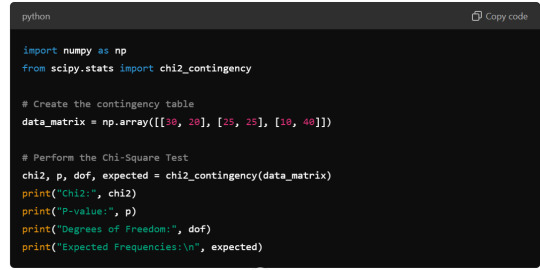
Output
R Output:

Python Output:

Interpretation
The Chi-Square Test of Independence produced a chi-square statistic of 25.066 with a p-value of approximately 1.34e-05. Since the p-value is significantly less than the typical alpha level of 0.05, we reject the null hypothesis and conclude that there is a significant association between Variable A and Variable B.
Post Hoc Analysis
Given that the Chi-Square Test indicates a significant association, we need to perform a post hoc analysis to determine which specific group pairs contribute to the observed significant association.
Post Hoc Analysis (Adjusted Residuals):
To identify which cells contribute significantly to the Chi-Square statistic, compute the standardized residuals.
R Syntax for Residuals:

Python Syntax for Residuals:

Interpreted Residuals: Significant residuals indicate which cells in the contingency table contribute most to the chi-square statistic. For instance, if the standardized residual for Group 3 and Outcome 2 is notably high, it suggests an unexpected high frequency in that cell compared to what was expected under the null hypothesis.
0 notes
Text
Running a Chi-Square Test of Independence Assignment
My Program:

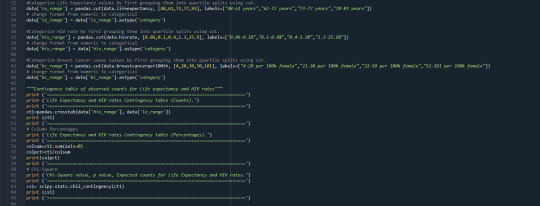

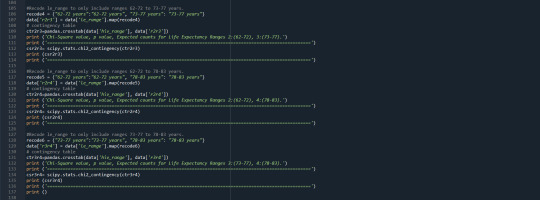



Program Output and Summary:
Chi-Square Test Results for life expectancy and HIV rate
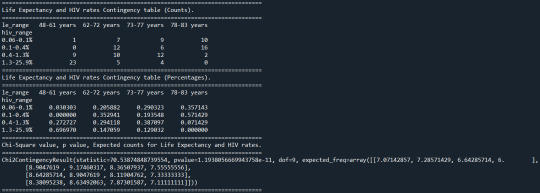
A Chi Square test of independence revealed that among the countries in the GAPMINDER Dataset, the life expectancy (the categorical explanatory variable, collapsed into 4 ordered categories) and the HIV rate ranges (the categorical response variable, collapsed into 4 ordered categories) were significantly associated, X2 = 70.53, 9 df, p = 1.19e-11.
Post-Hoc Chi-Square Test results for life expectancy and HIV rate
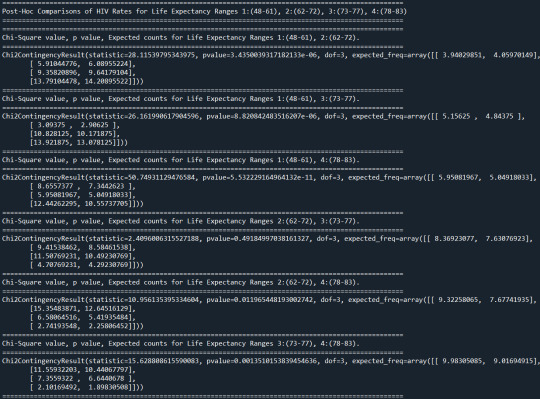
Post hoc comparisons of HIV rate ranges by pairs of life expectancy ranges revealed that prevalence of HIV was statistically similar among countries with 62-72 years life expectancy and countries with 73-77 years life expectancy. Prevalence of HIV rates was statistically different between all other life expectancy ranges. More specifically, higher HIV rate ranges were common for countries with lower life expectancy ranges.
Chi-Square Test Results for life expectancy and breast cancer cases

A Chi Square test of independence revealed that among the countries in the GAPMINDER Dataset, the life expectancy (the categorical explanatory variable) and the breast cancer case ranges (the categorical response variable, collapsed into 4 ordered categories) were significantly associated, X2 = 84.17, 9 df, p = 2.38e-14.
Post-Hoc Chi-Square Test results for life expectancy and breast cancer cases

Post hoc comparisons of breast cancer case ranges by pairs of life expectancy ranges revealed that lower breast cancer case ranges were significantly more common among countries within 48-61 year life expectancy range, than among countries within 73-77 year and 78-83 year life expectancy ranges. Post hoc comparisons also revealed that higher breast cancer case ranges were significantly more common among countries within 78-83 year life expectancy range, than among countries within 62-72 year and 73-77 year life expectancy ranges.
In contrast, prevalence of breast cancer was statistically similar between countries within 48-61 year and 62-72 year life expectancy ranges, as well as between countries within 62-72 year and 73-77 year life expectancy ranges.
0 notes
Text
Shape 1: Skewed Right
Shape 2: Skewed Right
2K notes
·
View notes
Text
Reference archived on our website
This is an issue with far too little study done. It also makes the ban on gay men (and trans women) giving blood because of the potential for HIV seem all the more silly when nearly everyone who gives blood in the US has had at least one covid infection since 2020.
Abstract Background In 2022, the SARS-CoV-2 Omicron surge affected 8.8 million people in Taiwan. This study delves into how the transition from containment to mitigation strategies in COVID-19 control has altered concerns regarding transfusion safety.
Methods Blood donations during 2020–2022 in Taiwan were included. Donation details and post-donation information (PDI) were retrieved to assess donation fluctuations and incidences of various PDI. The main effects of PDI reporting were assessed using chi-square test and logistic regression. Additionally, from April to August 2022, we collected disease information from COVID-19 donors, and tested their repository specimens for SARS-CoV-2 RNA and antibodies.
Results Before 2022, when containment measures were in place, only 8 blood donors with COVID-19 reported PDI. However, by mid-2021, there was a significant decrease in blood donations. In 2022, with mitigation strategies implemented, a total of 3483 donations reported COVID-19 PDI. The incidence of all cause PDI increased from 10.5 per 10,000 donations in 2020–2021 to 29.9 per 10,000 in 2022, with nearly 70% of PDI being related to COVID-19. Female donors reported more PDI events. Additionally, the incidence significantly decreased with age. A total of 1148 repository specimens from COVID-19 donor were tested, revealing no detection of SARS-CoV-2 RNA. The seroprevalence rates of anti-nucleocapsid(N) and anti-spike(S) antibodies were 0.61% and 98.4%, respectively.
Conclusion Transfusion safety concerns in Taiwan progressed alongside the evolution of control strategies, with a one-year delay following the pandemic started. The absence of RNAemia among COVID-19 donors indicates that precautionary measures were commensurate with the risk.
PDF Link: pdf.sciencedirectassets.com/276220/AIP/1-s2.0-S0929664624004078/main.pdf?X-Amz-Security-Token=IQoJb3JpZ2luX2VjEHkaCXVzLWVhc3QtMSJIMEYCIQDtypwhWajL3XC253cVb6ZNKMbwDNp6jgtcURJpktk%2FSgIhAPM1UeAQ8OwCdo1aZxlQQ4L2THphJ3P81Xbsshkew6u2KrwFCLL%2F%2F%2F%2F%2F%2F%2F%2F%2F%2FwEQBRoMMDU5MDAzNTQ2ODY1Igz%2Bx%2BDYSAK%2FRTPcpHcqkAUfb6cmkl4IhHmwP%2B0ZzRZKxvyKgc%2F2AFPpg%2F5EkaoejS1A6GwsG%2BGeWY%2FHJnRVKrMZDYBByGGFYBd7Kl79rNF54Vb8WB6pFcaa9FnQMQWqHcMtgrPFwytleYXWH04d15z0vI5pZGD2N33WUoYyCP2SWTqbIa%2FFRkhqgRLlY7aMfFYAeybdOGhgbqnPbVHKNTtPHAr83vd7opEVB%2FYI9bVVXdlutn5m2QL874KfV6CrTZjxRPUs9a6pEpkcmBqS%2FBuJjfMv9%2F9%2FQhDbdYXiAIy4KI9tmerzCACYHbiBWXr1v9bLBrQ0vdMAnadkNlPYGttR0mJLAHuLK3EYYDzyD3BG5ri9zXJm7IO0BTfh8ra3B4XV1NCm2txFC2ACYH4Y54F04NBSDHSGeHSsEyVvu%2Fz68DZHs8Waxfdm%2BtFfJOSXE%2BAcvsrW0wTF4jhk%2BLTMu1erekb1NCw5Llx5iZpcOn%2BezOApPW56nW31n1VgDh7wBCsRq685W11CGiIwcqvwd8pJH1EAgfQ4amrn3sfVC%2B22flmZqaAsN2kVkfRk7GO3LOfFWR9c1DgaPGEPIma83j3pSz%2BAkFKZbMnW9XrOVITFgbbhLkgGB0u5QSTuR4XfgUI217Jy07bosxuRDdHadvlavnX2FkMb1nVQGsMgC3Yl41koRJehVeljQA3zJ1jMmZtHfm2fUjtbxVtAlID%2BUepDR3SwYcEiDYQplM28mFCwrsabyP0y81AjcEadicH9MAub34aHpCH9lq0E9%2BwvE50ygeKvTGa2QFKr%2FKMKPWCMpAfLQO8Iq4ci876Sz9i0pwYsz56PSSTOZqmIuvcsTpiRwK29693pqIbFk366fzE7wKuRZipy%2FIIsIPhk49mNLDDV%2B8K3BjqwAVbQTLyuiW9cZbBMWTzoG8sB6%2F7Tu0rlfzbWrI86Y0XpNYHQ4lfscFOr4bQeW04Dg6eduakfoeylbmUPxVdjcuAiqZxMKWw7DW4j7odg9BhfaU22tqj4FoTF0mKRu920W1K2LI7MSTZ2FmGsP0IdlHKhzSlw4ALZFcQCIifrfrwjn8bf07oCuBUXhdSwFJiRGVURZzXlui2oZUSpbBmrFPTuL0GuvWXr%2Be1mk4mQDC3c&X-Amz-Algorithm=AWS4-HMAC-SHA256&X-Amz-Date=20240923T014252Z&X-Amz-SignedHeaders=host&X-Amz-Expires=300&X-Amz-Credential=ASIAQ3PHCVTY4FZKJMDF%2F20240923%2Fus-east-1%2Fs3%2Faws4_request&X-Amz-Signature=b164b5228d59cec0937af8f03afb64239adbb65066baddd16efbf085353a2fdc&hash=2cf460b85bd79677372b88d052b288b7bc32a58429b52f459102501962acb59f&host=68042c943591013ac2b2430a89b270f6af2c76d8dfd086a07176afe7c76c2c61&pii=S0929664624004078&tid=spdf-362f3e80-e162-4ee7-bb62-39ce4c3a60a3&sid=6bc94e215859e34e3758e1f3ee711ec038d7gxrqa&type=client&tsoh=d3d3LnNjaWVuY2VkaXJlY3QuY29t&ua=1b175a03505205525c&rr=8c76d733bfdde6fe&cc=us
#mask up#covid#pandemic#covid 19#wear a mask#public health#coronavirus#sars cov 2#still coviding#wear a respirator
54 notes
·
View notes
Text
I finished my data analysis for POV distribution in TRC! Figure captions are in the alt text. Other observations, discussion of the analysis and results, and some supplemental figures are under the cut. This is perhaps the most self-indulgent project I've worked on <3



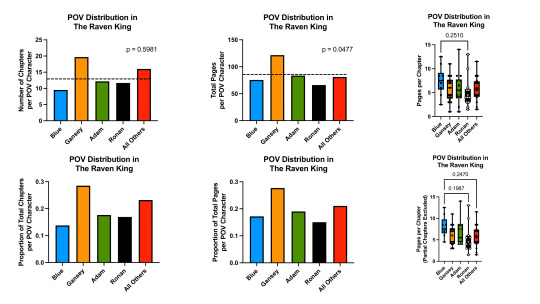
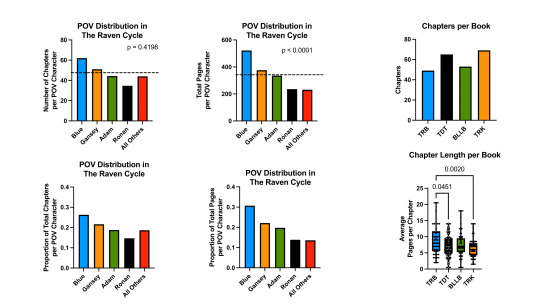
Other observations: I went into this analysis with the hypothesis that each of the four protagonists would have the most chapters and/or pages in the following pattern: Blue for TRB, Ronan for TDT, Adam for BLLB, and Gansey for TRK. This mostly held true, although Blue had more chapters and pages than Adam in BLLB. This trend was more significant in terms of page distribution compared to chapter distribution. Mean chapter length differences were infrequent and did not follow the expected pattern, although I did see trends towards shorter chapters for antagonists not grouped into "all others."
There is a relative lack of back-to-back chapters for the same POV character, although this does occur in all books (twice for Blue in TRB; once for The Gray Man, twice for Adam, and six times for Ronan in TDT; five times for Blue [two of which are back-to-back-to-back], once for Gansey, twice for Adam [one of which is back-to-back-to-back], and once for Greenmantle in BLLB. I mention all of this to say that in TRK, this occurs once for Ronan, once for Blue, once for Adam, and thrice for Gansey- but in one of these instances, Gansey has SIX chapters in a row. Nine of the chapters from 48 to 58 are from his POV. The Raven King indeed!
Analysis notes:
For each book, I counted how many chapters each POV character had and how many pages each POV character had. Page numbers are based on the UK paperback editions of the series. In the figures, I show raw # of chapters and pages, as well as the proportion of chapters and pages attributed to each POV character over the total number of chapters or pages. I also compared POV characters’ pages/chapter ratio and tested for differences in mean chapter length with a one-way ANOVA with multiple comparisons.
For most measures, in cases where chapters had multiple POV characters in sequence, I divided the chapter by # of characters. For example, chapter 44 in TRB starts with Adam, switches to Whelk, and ends with Blue. This chapter counted as 1/3 chapter for each character. In BLLB, only the prologue contained multiple discrete POV sections (Persephone, Calla, and Maura) and Piper only had her POV featured in the epilogue so I grouped these two chapters as “All Others” and excluded them from statistical tests. For TRK and TRC, I did include the "All Others" category in the analysis. (“All Others” includes chapters/pages with ambiguous POV (Kavinsky’s text in TDT- are we reading it from the sender or the recipient’s POV?), mixed/omniscient POV (the Gray Man’s tarot reading in TDT – we get internal thoughts and feelings from multiple characters), and in TRK, any character aside from Blue, Gansey, Adam, and Ronan.)
In figures that represent raw counts of chapters or pages, the dashed horizontal line represents the expected number of chapters or pages per POV character if the distribution was equal. The p values on these figures represent the results of a Chi-square test to test whether the actual distribution of pages or chapters was different from an equal distribution.
For the pages/chapter ratio data and the Chi-square tests, I did not apply this calculation and counted each discrete POV as a full chapter because I needed counts and sample sizes to be integers for the statistical analysis (Gansey having an n = 8.5 was not making GraphPad prism very happy with me). I had to do a bit of rounding to the nearest number which was not ideal, but I did this as little as possible. (There is probably a workaround for this, at least for the ratio data, but I am not a statistician). To at least approximate what results would look like without the skew towards a lower pages/chapter ratio, I also ran the ANOVA only with chapters containing a single POV character, which is why you’ll see two figures for the pages/chapter metric for each book (except for BLLB).
I am considering p values < 0.05 to be significant; I have included non-significant p values on some figures to provide additional context. If there is no p value on a given figure, you can assume I found no significant differences amongst POV characters’ chapters and/or pages in my analysis.
If you have questions about the analysis please let me know! :)
Supplemental figures: TRK data shown for all unique POV characters (these figures do not have captions in the alt text; the four on the left depict distribution of chapters and pages across the 19 different POV characters in TRK; the vast majority of the chapters and pages are attributed to either Blue, Gansey, Adam, or Ronan. The two figures on the left show mean pages per chapter for all characters, with no clear/statistically significant trends across the data. The demon's chapters are noticeably short.)

#rchl#trc#trc data#the raven cycle#the raven boys#the dream thieves#blue lily lily blue#the raven king#this was sooooooo fun btw do we want setting data next maybe?#im also working on a more language driven project about usage of camaro vs pig#also i have reached self parody by including a supplemental section like that is truly absurdly me
614 notes
·
View notes
Text
Let's see if this is really a thing that exists...
The goal of this poll is not to be judgemental of anyone or cause arguements (If the comments get too much on fire I may delete it), just to check is this a fandom-wide thing, or am I imagining it. Without jumping to conclusions. Or at least I will try my best not to jump, but then, I am myself in a peculiar position on this scale so... anyway.
Poll. And instructions (below).
Not where you live but how do you culturally identify ("partially" counts).
Sorry for vague poll options, "Valar&co" is not well defined, but I hope you get the vibe. If you support different sides on different points in history (FA vs War of the Ring, for example), try to average it.
The Valar, and Eonwe, and Gandalf and the likes. "I am a proud Feanárion and hate both Morgoth and his kin [the Valar]" counts as "I don't take a clear side". Sorry, I … ok, technically I could add this as fourth option, but then I'd have no slots left for the "nuanced potato". :(
Also, I don't think anyone other will need this clarification, but "needs to get over his bs because I like him for no clear reason" does not count as "support". Not enough. If I made a more detailed poll then maybe it would count as half of a point.
Oh, but also: If your support for Mairon comes down to "he should get away from Morgoth asap and get a redemption arc", it counts as "I support the Valar more".
Please vote (or even reblog), if this gets enough votes I will be able to do a chi-square test and maybe get some results! But the subtler the correlation the more votes this test needs to work.
#silm#silmarillion#tolkien legendarium#the silm#the silmarillion#silm polls#melkor#morgoth#mairon#sauron#silm fandom#sorry for complicated instructions
37 notes
·
View notes